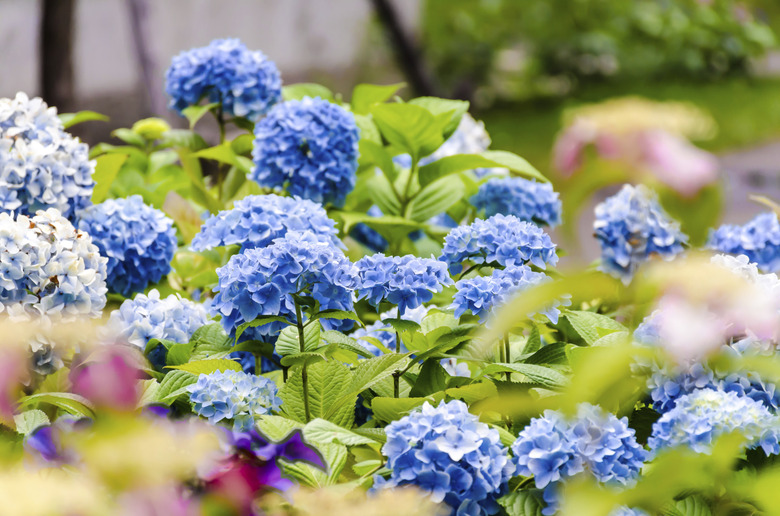How Do I Take Care Of An Endless Summer Hydrangea?
When Endless Summer bigleaf hydrangea (Hydrangea macrophylla "Bailmer") burst onto the scene in the early 2000s, it was the first hydrangea of its kind to bloom on both old wood and new stems from the current year. Before that time, similar hydrangeas bloomed only in spring on stems that withstood winter. For gardeners in northern climates, a cold harsh winter could wipe out a whole year's blossoms. With Endless Summer and its Endless Summer Collection companions, gardeners enjoy blooms from late spring to fall. All Endless Summer Collection hydrangeas thrive with the same basic care.
Light and Water
Proper sunlight and moisture encourage abundant, healthy Endless Summer blooms. In most climates, the plants need full morning sun and filtered afternoon shade. In northern gardens with weaker rays, six hours of morning sun rewards with more blossoms. In southern climates, limit morning sun to two hours and protect the plants from harsh sun with afternoon shade. Endless Summer prefers moist, well-drained soil. Too much water diminishes blooms. In hot climates, the plants may wilt, but they bounce back quickly. Water well and let the soil dry to the touch before watering again. Water the soil directly, and avoid wetting Endless Summer foliage.
Soil and Fertilizer
Fertile soil, high in organic matter, fuels this hydrangea's endless blooms. Average garden soil benefits from organic compost to improve soil structure and aeration, while adding gentle nutrients. Prior to planting, layer 2 to 6 inches of organic compost over the planting bed and incorporate it 6 to 8 inches deep. Endless Summer's heavy reblooming nature warrants a single nutritional boost in early summer. Use a granular, slow-release fertilizer with a higher middle number. Avoid high nitrogen; it inhibits blooms. Work about 1/2 cup of 15-30-15 fertilizer into the soil around each established plant; read the label on your fertilizer for specific instructions. Water well before and after you fertilize, and keep fertilizer 6 inches from the stems. Wear protective clothing, including gloves and safety eyewear, whenever you work with chemicals.
Pruning and Protection
Endless Summer's heaviest flowering occurs early in the season, on the prior year's growth. Pruning and winter protection combine to protect those old-wood flower buds from winter cold. All Endless Summer Collection varieties are hardy in U.S. Department of Agriculture plant hardiness zones 4 through 9. In cold climates, cut your hydrangeas back to 12 to 15 inches tall after fall's first hard freeze. Then cover the plants with a thick layer of leaves, straw or mulch. Remove it once frost threats pass in spring. In warm climates, keep pruning to a minimum. When plants show buds in spring, prune off any dead tips or damaged wood. Use sharp bypass pruners for crisp cuts, and sterilize the blades with household disinfectant before and after each bush.
Pests and Disease
Endless Summer hydrangeas have few problems with pests or disease. If aphids take up residence on tender new growth, a quick water-hose blast sends them packing. In cramped quarters or humid climates, fungal diseases may creep in. Remove affected leaves, and clean the area thoroughly of debris. Avoid overhead watering to reduce disease transmission. If you chose to treat with fungicide, a ready-to-use, chlorothalonil-based product helps. Spray foliage and stems thoroughly at the first sign of disease. Avoid getting the fungicide on blooms; it can cause discoloration. Repeat every seven to 14 days, as needed. Wear protective clothing, as with all chemicals.
Flower Color
Endless Summer bloom color depends on aluminum in your soil and soil pH. In acidic soil with aluminum present, blooms are naturally blue. In soils that lack aluminum or have alkaline pH, Endless Summer blooms are pink. Beautiful purple blossoms fall in between. Change your bloom color by manipulating soil pH and aluminum. For example, watering with a mixture of 1 tablespoon of aluminum sulfate in 1 gallon of water monthly, for three months in spring, lowers soil pH, increases aluminum and enhances blue blooms. Always get a professional soil test before adjusting soil extensively. If your soil has abundant aluminum, adding more can leave soil toxic to plants.
